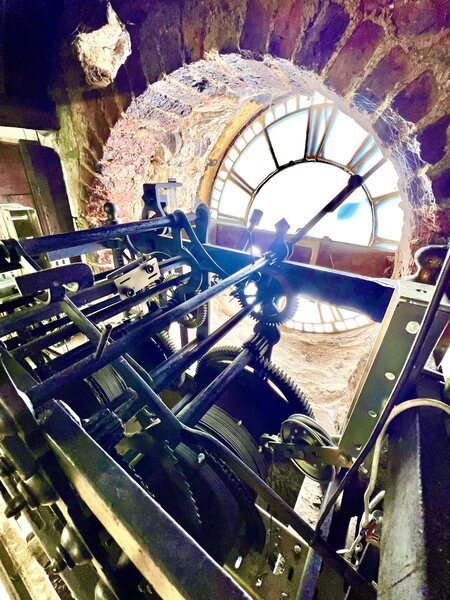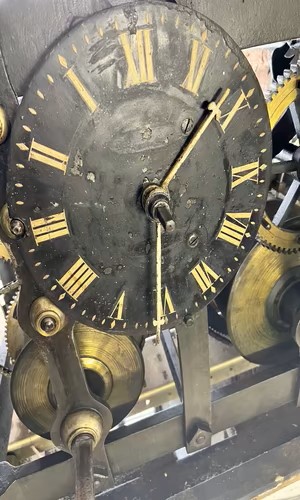The Ecclesfield Tower Clock
A 'Clock' is a timekeeping device that makes a noise (strikes on a bell or gong)
A timekeeping device that is quiet and does not strike is called a Timepiece.
The clock dates to 1800 to 1820. It has no date marks on it and has no makers mark. We think it is the work of John Thwaites company of London. It is thought that this clock replaced an earlier clock and dial, but nothing is known about this clock. There is evidence of fixings and holes in the wall that do not relate to the current clock.
The diamond shaped stone around the outside dial is called a lozenge. In the earliest photos of the church this is a stone faced dial. Our current clock has a glazed clock face, or a skeleton dial as it is known. Each section is glazed with Victorian glass and held in place by a metal skeleton. It is illuminated from behind at night by an LED lamp on a timer. The dial is surrounded by the diamond shaped stone lozenge, this was probably installed around 1900.
This is a photo taken from inside the ringing room with the clock cupboard opened up and looking over the top of the clockwork.

The clock is a two-train turret clock with one dial on the south wall. The "Going Train" drives the hands round the dial, the "Striking Train" strikes the hours on the Tenor bell. The trains (sets of gears) are held in an iron frame in the ringing chamber high up on the wall directly behind the clock face. The clock frame is sectional. There are sections bolted together to form a rectangular enclosure with the gears and rotating shafts also bolted to the frame.
The photo shows the inside face of the clock mechanism. You will notice that the hands go the wrong way (anti-clockwise) round the dial as they are on the opposite end of the shafts carrying the main clock fingers on the outside face. In this example they are showing the time at about 10.29

The mechanical (clockwork) clock is regulated by a pendulum approximately 8 feet long which takes 1.5 seconds to swing in 1 direction therefore it is said to have a 3 second period. The pendulum is housed in a cupboard in the ringing chamber under the clock mechanism. The clock strikes the hour on the Tenor bell (see below) when it is in its 'down' position. Ecclesfield does not have quarter chimes.
Up to 20th March 2007 the clock and the chimes were wound by hand once per week. It is now wound automatically by two electric motors. At the same time It was fitted with an electronic pendulum arrestor which automatically stops the clock to adjust it for GMT and BST. The pendulum is stopped by a motorised electromagnetic arm device which moves over and holds the pendulum at the end of its swing. After 1 hour or 11 hours when the correct time is reached the magnet releases the pendulum, the arm moves out of the way. The clock is kept accurate by the electronic clock that activates the pendulum arrestor.
The clock gains slightly therefore periodically the pendulum arrestor grabs and holds the pendulum still for the required number of seconds to put it right. This prevents the clock time drifting. The clock runs a few seconds fast over 24 hours but the pendulum arrestor regulating it means from the outside looking at the dial the time is always correct.
Breakdowns
Occasionally as with most mechanisms and unexpected fault can develop. We will do our best to sort it out in partnership with Sheffield City Council and the professional clockmkakers. If the clock has to be stopped for any length of time the hands will be parked at 12 oclock.